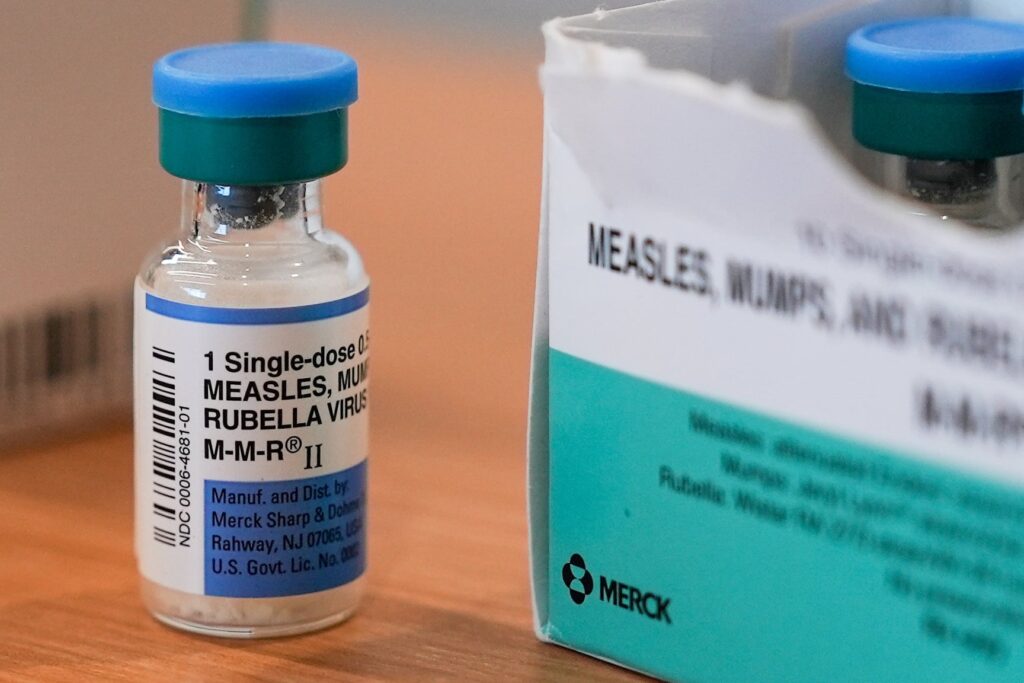Even though measles was proclaimed eradicated in the US in 2000, fresh evidence indicates that the highly contagious virus is making a comeback nationwide, including in Oregon, where a case was recently verified.
This week, the first measles case of 2025 was announced by the Oregon Health Authority. The state reported 31 confirmed instances last year.
The Centers for Disease Control and Prevention reported 1,214 confirmed cases of measles in 34 states and the District of Columbia as of last week. That is already about four times as many confirmed instances as there were in 2024.
What is causing the comeback? Nearly 90% of those who became ill were either unvaccinated or unaware of their vaccination status, and the majority of cases are associated with outbreaks, which are defined as three or more related diseases.
During a media briefing on Tuesday, Dr. Paul Cieslak, medical director for infectious diseases and immunizations at the Oregon Health Authority’s Public Health Division, stated that a sizable portion of the population in Oregon is unvaccinated. The risk is extremely low when measles is not present. However, the danger increases significantly when measles is present in the neighborhood.
What makes measles so dangerous?
When an infected person coughs or sneezes, the virus that causes measles travels through the air. The virus can spread from four days before to four days after a rash appears and can stay in the air for up to two hours.
According to Cieslak, people are contagious even before symptoms show up, which can happen up to 21 days after exposure, making it simple to unintentionally infect others.
Fever, cough, runny nose, and red eyes are early symptoms that frequently resemble those of other disorders. A distinctive red rash appears a few days later, typically beginning on the face and moving down.
Serious side effects from measles can also include pneumonia, cerebral edema, and, in extreme circumstances, death. Three confirmed measles-related deaths have occurred in the United States so far this year.
What are Oregon s vaccination requirements?
The majority of Oregonians have received the MMR (measles, mumps, rubella) vaccine, which has been widely used in the past to slow the virus’s spread. The CDC estimates that the vaccine is 97% effective after two doses.
Since 1973, the MMR vaccine has been required in Oregon schools. With the establishment of school exclusion day in 1981—the day of the academic year after which noncompliant kids are not allowed to attend school—enforcement measures were bolstered.
But for cultural, political, or religious reasons, parents can choose not to vaccinate their children, and according to Cieslak, Oregon currently has one of the highest nonmedical exemption percentages among kindergarteners nationwide.
According to state health data, 89% of Multnomah County children aged 19 months to 5 years are currently up to date on their first MMR vaccination. That falls short of the 95% coverage required for herd immunity, which is the degree of immunity in the population that stops the spread of measles. Almost two out of every three counties in the state had vaccination rates for schoolchildren and young children attending daycare centers that fall short of the herd immunity threshold.
According to Cieslak, some populations may become more susceptible to outbreaks as a result of decreased vaccination rates.
Who s considered immune?
A person is deemed immune to measles if they have received two recorded doses of the MMR vaccine over their lifetime.
According to the CDC, the vaccination has a 93% effectiveness rate against measles and a 97% effectiveness rate when administered in two doses. Additionally, during an outbreak, they don’t require extra dosages or antibody testing.
Since they were probably exposed to measles before vaccines were developed, adults born prior to 1957 are likewise assumed to have natural immunity.
According to Oregon health officials, those who have received a measles diagnosis at any time in their lives are also regarded as immune, as are those who have undergone a blood test that confirms their immunity.
Who should get a booster?
Those who had vaccinations between 1963 and 1968 might be at risk.
This is due to the fact that one of the two measles vaccines that were available at the time was ineffective and the immunity it produced was short-lived. According to Johns Hopkins University, between 600,000 and 900,000 Americans received that vaccine before it was phased out in 1968.
Health professionals advise those who aren’t sure if they are protected to just receive the vaccine because receiving another dosage won’t hurt them.
Before traveling, especially to nations where measles is more common, Oregon health officials highly advise people to confirm their vaccination status. Before traveling abroad, even infants between the ages of six and twelve months should receive the vaccination.
Can you check your immunity? Is it necessary?
A straightforward blood test called antibody testing, often known as a titer test, can determine a person’s immunity to measles, although doctors advise against using this technique until absolutely required.
Although titers can verify immunity, they can be costly, time-consuming to process, and potentially deceptive when assessing a person’s level of measles protection. The reason for this is that they might miss memory immune responses, which continue to offer defense even when antibody levels seem to be low.
According to specialists, a titer test is usually unnecessary if a person has two confirmed MMR doses. And the shot should be given to those who haven’t.
According to health officials, testing is only advised for those who are unable to receive the MMR vaccine due to pregnancy, severe immunological compromise, or being younger than six months old yet having been exposed to measles and not knowing if they have had the vaccine.
If administered quickly after exposure, the MMR vaccine can still provide protection for those who have been exposed but are unsure if they have received it.
How much does the measles booster cost?
Even if the deductible hasn’t been reached, the majority of insurance policies cover the MMR vaccine with no out-of-pocket expenses. Additionally, Medicare Part D covers it.
Most pharmacies, including CVS and Walgreens, carry the vaccination for people without insurance. Bettercare estimates that the typical cost per dose is between $90 and $125, which means that the entire series of two shots will cost between $180 and $250.
Who should not get the MMR vaccine?
The CDC states that some populations should not take the MMR vaccine, even if it is safe for the majority of people.
Pregnant women, those who have experienced a severe allergic reaction to a previous dose of the vaccine, and those with seriously weakened immune systems—such as those with advanced HIV infection, certain types of cancer, or those on drugs that significantly impair immunity—are among them.
Before receiving the vaccine, those with certain conditions might see their healthcare professional.





More Stories
Who’s immune to measles? What if you don’t know if you’re vaccinated? What you need to know
Who’s immune to measles? What if you don’t know if you’re vaccinated? What you need to know
Who’s immune to measles? What if you don’t know if you’re vaccinated? What you need to know